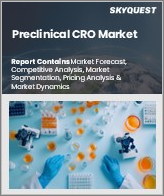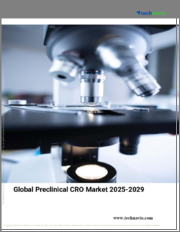
|
시장보고서
상품코드
1736972
세계의 전임상 CRO 시장 규모, 점유율, 성장 분석, 서비스별, 모델별, 용도별, 최종사용자별, 지역별 - 산업 예측(2025-2032년)Preclinical CRO Market Size, Share, and Growth Analysis, By Service, By Model (Patient-Derived Organoid Model, Patient-Derived Xenograft Model), By Application, By End User, By Region - Industry Forecast 2025-2032 |
||||||
전임상 CRO 세계 시장 규모는 2023년 64억 달러, 2024년 70억 1,000만 달러에서 2032년에는 146억 달러로 성장할 것으로 예측되며, 예측 기간중(2025-2032년) CAGR은 9.6%를 나타낼 전망입니다.
세계 전임상시험 수탁기관 시장의 성장은 계약 기반 CRO 서비스를 활용하는 바이오 제약사, 의료기기 기업, 정부 연구기관의 참여 증가에 의해 크게 촉진되고 있습니다. 만성질환 및 유전자 관련 질환의 급증으로 인해 이들 기업은 효과적인 진단 및 치료를 위한 혁신적인 의약품 및 기기 개발을 위한 연구에 많은 투자를 필요로 하고 있습니다. 전임상 CRO는 필수적인 R&D 솔루션을 제공함으로써 이들 기업이 핵심 활동에 집중할 수 있도록 돕고, 의약품 및 의료기기 개발 프로세스를 간소화합니다. 또한, 새로운 생명을 구하는 치료법에 대한 긴급한 수요는 전임상 연구에 대한 투자를 촉진하여 의약품 개발 및 상업화 전략에서 CRO의 중요한 역할을 확고히 하고 있습니다.
목차
서론
- 조사 목적
- 조사 범위
- 정의
조사 방법
- 정보 조달
- 2차와 1차 데이터 방법
- 시장 규모 예측
- 시장 전제조건과 제한
주요 요약
- 세계 시장 전망
- 공급과 수요 동향 분석
- 부문별 기회 분석
시장 역학과 전망
- 시장 개요
- 시장 규모
- 시장 역학
- 성장 촉진요인과 기회
- 성장 억제요인과 과제
- Porter의 Five Forces 분석
주요 시장 인사이트
- 중요 성공 요인
- 경쟁 정도
- 주요 투자 기회
- 시장 생태계
- 시장의 매력 지수(2024년)
- PESTEL 분석
- 거시경제 지표
- 밸류체인 분석
- 가격 분석
전임상 CRO 시장 규모 : 서비스별&CAGR(2025-2032)
- 시장 개요
- 생체 분석 및 DMPK 연구
- 시험관내 ADME
- 생체내 PK
- 독성 시험
- GLP
- 비GLP
- 화합물 관리
- 프로세스 연구개발
- 커스텀 합성
- 기타
- 화학
- 의약화학
- 계산화학
- 안전성 약리학
- 기타
전임상 CRO 시장 규모 : 모델별&CAGR(2025-2032)
- 시장 개요
- 환자 유래 오가노이드(PDO) 모델
- 환자 유래 이종 이식 모델
전임상 CRO 시장 규모 : 용도별&CAGR(2025-2032)
- 시장 개요
- 종양학
- 신경학
- 심장병학
- 감염증
- 대사장애
- 기타
전임상 CRO 시장 규모 : 최종사용자별&CAGR(2025-2032)
- 시장 개요
- 제약 기업 및 바이오테크놀러지 기업
- 정부기관 및 학술기관
- 의료기기 기업
- 기타
전임상 CRO 시장 규모&CAGR(2025-2032)
- 북미
- 미국
- 캐나다
- 유럽
- 독일
- 스페인
- 프랑스
- 영국
- 이탈리아
- 기타 유럽
- 아시아태평양
- 중국
- 인도
- 일본
- 한국
- 기타 아시아태평양
- 라틴아메리카
- 브라질
- 기타 라틴아메리카
- 중동 및 아프리카
- GCC 국가
- 남아프리카
- 기타 중동 및 아프리카
경쟁 정보
- 주요 5개사 비교
- 주요 기업의 시장 포지셔닝(2024년)
- 주요 시장 기업이 채택한 전략
- 최근 시장 동향
- 기업의 시장 점유율 분석(2024년)
- 주요 기업 개요
- 기업 상세
- 제품 포트폴리오 분석
- 기업 부문별 점유율 분석
- 매출 전년대비 비교(2022-2024년)
주요 기업 개요
- Charles River Laboratories International, Inc.(USA)
- Labcorp Drug Development(USA)
- Eurofins Scientific(Luxembourg)
- ICON plc(Ireland)
- IQVIA(USA)
- Parexel International Corporation(USA)
- PPD(USA)
- Syneos Health(USA)
- Crown Bioscience(USA)
- Envigo(USA)
- Intertek Group plc(UK)
- SGS SA(Switzerland)
- MPI Research(USA)
- Worldwide Clinical Trials(USA)
- Inotiv, Inc.(USA)
- Jubilant Biosys Ltd.(India)
결론과 제안
LSH 25.06.13Global Preclinical CRO Market size was valued at USD 6.4 billion in 2023 and is poised to grow from USD 7.01 billion in 2024 to USD 14.6 billion by 2032, growing at a CAGR of 9.6% during the forecast period (2025-2032).
The growth of the global preclinical contract research organization (CRO) market is significantly fueled by the increasing engagement of biopharmaceutical companies, medical device firms, and government research agencies, who leverage CRO services on a contractual basis. The surge in chronic and gene-related diseases necessitates substantial investment from these companies in research aimed at the development of innovative drugs and devices for effective diagnosis and treatment. Preclinical CROs enable these organizations to concentrate on core activities by providing essential research and development solutions, thereby streamlining the drug and device creation process. Additionally, the urgent demand for new life-saving therapies is propelling investments in preclinical research, solidifying the crucial role of CROs in drug development and commercialization strategies.
Top-down and bottom-up approaches were used to estimate and validate the size of the Global Preclinical CRO market and to estimate the size of various other dependent submarkets. The research methodology used to estimate the market size includes the following details: The key players in the market were identified through secondary research, and their market shares in the respective regions were determined through primary and secondary research. This entire procedure includes the study of the annual and financial reports of the top market players and extensive interviews for key insights from industry leaders such as CEOs, VPs, directors, and marketing executives. All percentage shares split, and breakdowns were determined using secondary sources and verified through Primary sources. All possible parameters that affect the markets covered in this research study have been accounted for, viewed in extensive detail, verified through primary research, and analyzed to get the final quantitative and qualitative data.
Global Preclinical CRO Market Segments Analysis
Global Preclinical CRO Market is segmented by Service, Model, Application, End User and region. Based on Service, the market is segmented into Bioanalysis and DMPK studies, Toxicology Testing, Compound Management, Chemistry, Safety Pharmacology and Others. Based on Model, the market is segmented into Patient-Derived Organoid (PDO) Model and Patient-Derived Xenograft Model. Based on Application, the market is segmented into Oncology, Neurology, Cardiology, Infectious Diseases, Metabolic Disorders and Others. Based on End User, the market is segmented into Pharmaceutical and Biotechnological Companies, Government and Academic Institutes, Medical Device Companies and Others. Based on region, the market is segmented into North America, Europe, Asia Pacific, Latin America and Middle East & Africa.
Driver of the Global Preclinical CRO Market
A significant catalyst for the growth of the global preclinical Contract Research Organization (CRO) market is the swift expansion of the biopharmaceutical industry. As biopharmaceutical companies increasingly venture into the development of innovative drugs, they are turning to CROs to manage essential preclinical testing activities, including drug efficacy evaluations and toxicity assessments. This growing reliance on outsourcing preclinical research functions not only enhances efficiency but also allows biopharma firms to focus on their core competencies. Consequently, the demand for preclinical CRO services is anticipated to rise substantially in the future, driven by this ongoing trend in the industry.
Restraints in the Global Preclinical CRO Market
One significant restraint in the Global Preclinical CRO market is the potential loss of management control during the development process when outsourcing preclinical testing. Biopharmaceutical companies that engage third-party CROs may find themselves with diminished oversight of their research activities. This dependency can hinder progress, as it may lead to delays, miscommunication, and inconsistent results. Consequently, a lack of direct management can restrict innovation and efficiency, ultimately affecting the overall success of drug development projects. These challenges underline the importance of careful selection and communication when collaborating with contract research organizations.
Market Trends of the Global Preclinical CRO Market
The Global Preclinical Contract Research Organization (CRO) market is experiencing a significant trend toward the integration of automation and artificial intelligence (AI), revolutionizing research operations. This transformation facilitates faster and more accurate outcomes, allowing for optimized data processing and predictive modeling in drug development. As AI-driven solutions become widespread, they not only enhance efficiency but also significantly reduce time and costs associated with preclinical studies. This trend underscores a broader shift within the industry towards embracing cutting-edge technologies, indicating that the market is poised for continued growth and innovation as organizations increasingly leverage these advancements to streamline their operations and improve research productivity.
Table of Contents
Introduction
- Objectives of the Study
- Scope of the Report
- Definitions
Research Methodology
- Information Procurement
- Secondary & Primary Data Methods
- Market Size Estimation
- Market Assumptions & Limitations
Executive Summary
- Global Market Outlook
- Supply & Demand Trend Analysis
- Segmental Opportunity Analysis
Market Dynamics & Outlook
- Market Overview
- Market Size
- Market Dynamics
- Drivers & Opportunities
- Restraints & Challenges
- Porters Analysis
- Competitive rivalry
- Threat of substitute
- Bargaining power of buyers
- Threat of new entrants
- Bargaining power of suppliers
Key Market Insights
- Key Success Factors
- Degree of Competition
- Top Investment Pockets
- Market Ecosystem
- Market Attractiveness Index, 2024
- PESTEL Analysis
- Macro-Economic Indicators
- Value Chain Analysis
- Pricing Analysis
Global Preclinical CRO Market Size by Service & CAGR (2025-2032)
- Market Overview
- Bioanalysis and DMPK studies
- In vitro ADME
- In-vivo PK
- Toxicology Testing
- GLP
- Non-GLP
- Compound Management
- Process R&D
- Custom Synthesis
- Others
- Chemistry
- Medicinal Chemistry
- Computation Chemistry
- Safety Pharmacology
- Others
Global Preclinical CRO Market Size by Model & CAGR (2025-2032)
- Market Overview
- Patient-Derived Organoid (PDO) Model
- Patient-Derived Xenograft Model
Global Preclinical CRO Market Size by Application & CAGR (2025-2032)
- Market Overview
- Oncology
- Neurology
- Cardiology
- Infectious Diseases
- Metabolic Disorders
- Others
Global Preclinical CRO Market Size by End User & CAGR (2025-2032)
- Market Overview
- Pharmaceutical and Biotechnological Companies
- Government and Academic Institutes
- Medical Device Companies
- Others
Global Preclinical CRO Market Size & CAGR (2025-2032)
- North America (Service, Model, Application, End User)
- US
- Canada
- Europe (Service, Model, Application, End User)
- Germany
- Spain
- France
- UK
- Italy
- Rest of Europe
- Asia Pacific (Service, Model, Application, End User)
- China
- India
- Japan
- South Korea
- Rest of Asia-Pacific
- Latin America (Service, Model, Application, End User)
- Brazil
- Rest of Latin America
- Middle East & Africa (Service, Model, Application, End User)
- GCC Countries
- South Africa
- Rest of Middle East & Africa
Competitive Intelligence
- Top 5 Player Comparison
- Market Positioning of Key Players, 2024
- Strategies Adopted by Key Market Players
- Recent Developments in the Market
- Company Market Share Analysis, 2024
- Company Profiles of All Key Players
- Company Details
- Product Portfolio Analysis
- Company's Segmental Share Analysis
- Revenue Y-O-Y Comparison (2022-2024)
Key Company Profiles
- Charles River Laboratories International, Inc. (USA)
- Company Overview
- Business Segment Overview
- Financial Updates
- Key Developments
- Labcorp Drug Development (USA)
- Company Overview
- Business Segment Overview
- Financial Updates
- Key Developments
- Eurofins Scientific (Luxembourg)
- Company Overview
- Business Segment Overview
- Financial Updates
- Key Developments
- ICON plc (Ireland)
- Company Overview
- Business Segment Overview
- Financial Updates
- Key Developments
- IQVIA (USA)
- Company Overview
- Business Segment Overview
- Financial Updates
- Key Developments
- Parexel International Corporation (USA)
- Company Overview
- Business Segment Overview
- Financial Updates
- Key Developments
- PPD (USA)
- Company Overview
- Business Segment Overview
- Financial Updates
- Key Developments
- Syneos Health (USA)
- Company Overview
- Business Segment Overview
- Financial Updates
- Key Developments
- Crown Bioscience (USA)
- Company Overview
- Business Segment Overview
- Financial Updates
- Key Developments
- Envigo (USA)
- Company Overview
- Business Segment Overview
- Financial Updates
- Key Developments
- Intertek Group plc (UK)
- Company Overview
- Business Segment Overview
- Financial Updates
- Key Developments
- SGS SA (Switzerland)
- Company Overview
- Business Segment Overview
- Financial Updates
- Key Developments
- MPI Research (USA)
- Company Overview
- Business Segment Overview
- Financial Updates
- Key Developments
- Worldwide Clinical Trials (USA)
- Company Overview
- Business Segment Overview
- Financial Updates
- Key Developments
- Inotiv, Inc. (USA)
- Company Overview
- Business Segment Overview
- Financial Updates
- Key Developments
- Jubilant Biosys Ltd. (India)
- Company Overview
- Business Segment Overview
- Financial Updates
- Key Developments



















